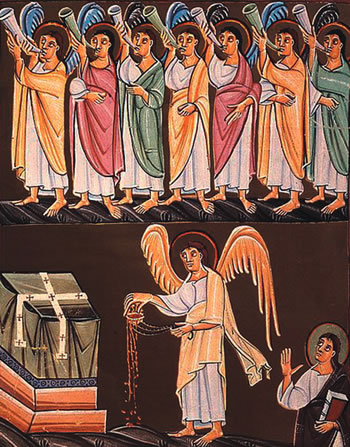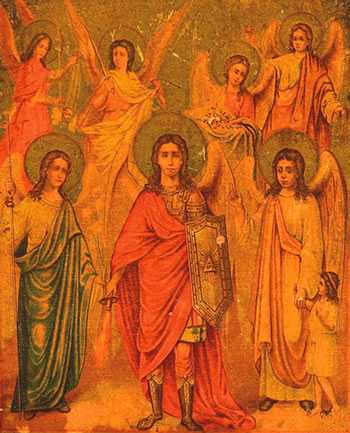The Book of Revelation (4) Chapters 7 to 11
The interlude that follows chapter 6 records the sealing of the servants of God. Here 144,000 (12 times 12 times 1000) are sealed, signaling the completeness of God’s promise to save ancient Israel. Also, God’s fidelity extends to a countless multitude of people from every tribe and language and nation. Chapter 6 ended with the question, who is able to stand? Chapter 7 provides the answer: those who have been redeemed by the Lamb, who is their shepherd. The seventh seal opens to clear the way for the septet of trumpets.
It may be good at this point to recall that Revelation is NOT written in chronological fashion. For example, in 8:7 all the green grass is destroyed, but in 9:14 the locusts are told not to harm the green grass. We will notice this again at the end of the trumpet septet.
The first five trumpets announce judgments that remind us of the plagues against Egypt in Exodus 7-10. (The third trumpet is an exception, based on Jeremiah 23:15.) In these plagues one-third rather than the one-fourth of humanity in the seals is affected. The plagues are directed against the “inhabitants of earth,” a phrase John uses to mean all who do not follow God. In Exodus, we see God sending plagues as judgment against the sins of the Egyptians. But ironically, the plagues against Egypt provided salvation for God’s people. The plagues brought judgment but their goal was redemption.
We are introduced to the seven angels who stand before God. These are the archangels (Raphael, Uriel, Raguel, Michael, Sariel, Gabriel and Remiel). These seven are given trumpets to announce the next judgments. In addition to images from Exodus and Jeremiah, John’s imagery may also have been suggested by storms, earthquakes and eclipses of the first century. The eruption of Mount Vesuvius in 79 A.D. may also have provided some of the imagery. The volcano destroyed ships in the Gulf of Naples. John’s readers would have been able to picture in the volcanic eruption “something like a great mountain, burning with fire, being thrown into the sea” (8:8).
As in the septet of the seals, so also in the trumpets, the fifth and sixth trumpets are described in greatest detail. In the fifth and sixth trumpets, John is deliberately creating a nightmare. From the bottomless pit are released monster locusts that do not attack vegetation, but humans. Those not sealed by God are attacked for five months, but cannot die. The Parthian cavalry, greatly feared by Rome, can be seen in the descriptive details John gives. The king of the bottomless pit is Apollyon, “destroyer.” The Roman emperor considered himself a descendant of the god Apollo. John is satirically calling the emperor a grasshopper. In the sixth trumpet, an army of 200 million is set loose on the east side of the Euphrates River. Those who mistakenly want to read Revelation as predicting our future consider this army to be modern China’s. Once again John was thinking of the Parthian Menace, not the Red Menace.
In chapters 10 and 11, God decides upon a new plan. God had used the suffering of Jesus to redeem our world. Now God will use the sufferings of Christians to lead people to repentance. There appears an angel “wrapped in a cloud,” a reminder of the divine presence with “a rainbow over his head,” a reminder of divine mercy (see Genesis 9:13). The angel holds a scroll. The great scroll in chapter 5 revealed God’s purpose achieved by Jesus. This little scroll in chapter 10 reveals God’s purpose for the Church. God will use the faithful suffering of Christians to reach unrepentant humanity. John is instructed to eat the scroll. It is sweet in the mouth for it is the good news of salvation. It is bitter in the stomach because it involves the martyrdom of the saints.
John is told to measure the temple, a symbol for the Christian community (see 1 Corinthians 3:16 and Ephesians 2:21). This measuring refers to the preservation of true service to God within the Church, and is also God’s promise to care for his people even during persecutions. (Note that the outer courtyard is not measured. This is usually considered to refer to part of the Christian community that has succumbed to the influence of paganism.) John adds a reference to forty-two months. This time period (or any of its equivalents) echoes the time of persecution the Jews suffered in the second century B.C. under the Seleucid Greek king Antiochus Epiphanes. Forty-two months is not a literal time. John is symbolically speaking of any period of persecution.
And persecution does occur. “And I will grant my two witnesses authority to prophesy for one thousand two hundred sixty days [42 months], wearing sackcloth.” The witnesses (Greek: martyrs), the people of God who bear faithful testimony, are delivered not from martyrdom and death, but through martyrdom and death to a glorious resurrection. Is John thinking of Zechariah 4:1-14?
Are the two witnesses Joshua and Zerubbabel? Or does he have Moses (Exodus 7:17, 19) and Elijah (2 Kings 1:10) in mind? Actually, neither pair totally satisfies what John writes. Perhaps it is simply better to understand the two witnesses as representing the faithful Christian community. Scripture scholar Bruce Metzger writes: “The violent death of the two witnesses, their resurrection after three and a half days, and their ascension into heaven are to be taken not as historical events, but as symbolic of the resurrection of the Church, which though seeming to be defeated, yet will live.”
Finally, at the seventh trumpet “the rest” of sinful humanity “were terrified and gave glory to the God of heaven.” They gave up their idolatry, murder, fornication and such, to which they had tenaciously held despite the seals and the trumpets. Finally, we hear, “The kingdom of the world has become the kingdom of our Lord and of his Messiah, and he will reign forever and ever.” (Can you hear Handel’s masterpiece?) This would be a fitting place for the book to end, but in fact we’re only half way through. John will take us through the cycle once more. Metzger reminds us: “…the sequence in which John’s visions are presented does not allow us to turn the book of Revelation into an almanac or time chart of the last days.”
Next month: Revelation 12-15



 Entries(RSS)
Entries(RSS)